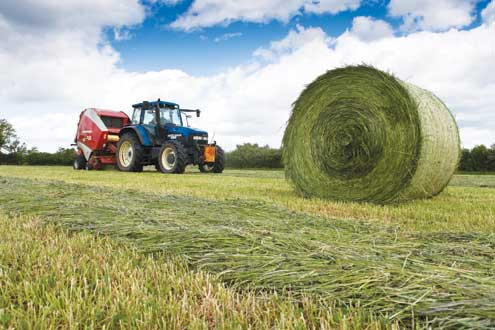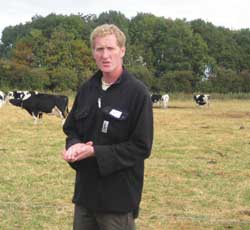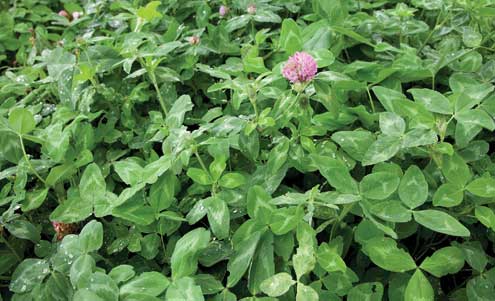Bales offer cost and flexibility advantages

Farmers in a range of systems are reaping the benefits of baling their silage instead of clamping it.
The farmers say bales offer more flexibility than clamp silage and that they have become integral to their feeding systems.
 Using bales to maintain the grazing wedge
Using bales to maintain the grazing wedge
Milk producer Keith Davis (pictured) manages the quality of his grazing platform by producing big bale silage from grass exceeding 3,000kg/DM/ha.
Mr Davis, who runs a 640-cow herd at Lydney Park, Chepstow, measures his pastures weekly, plotting the height on a grass wedge system to highlight when there is too much grass for the rotation.
Any fields exceeding 3,000 kg/DM/ha are locked up and made into big bale silage. Mr Davis says this provides an opportunity to correct mistakes made with grazing residuals. “It enables us to keep grass quality high for the grazing season and it provides us with good quality silage for the 600 cows and youngstock that we outwinter. It’s a win-win situation.”
He describes the system as a management tool for managing grass. And about 400 bales of relatively young grass are harvested from the milking platform annually.
He admits a 3,000kg cover is not a great volume of grass but it makes high quality silage with an ME of 12MJ/kg/DM or higher.
“Last year was a particularly dry year but we still made enough bales of silage, only it was later in the year because we needed all the platform for grazing. We cut in July and August. But this year it has been wetter so we will be making quite a lot in June and July,” he says.
The bales cost him £18 a bale to grow, harvest, bale, wrap and stack. With a dry matter content of 180kg this equates to 10p/kg/DM, compared to concentrates at 20p/kg/DM.
“It is very cheap and an ideal feed for outwintering. We also have some bales about if we do go through a period when we are short of grass and need feed,” adds Mr Davis.
He says he would struggle to get the cows to leave a good residual from grazing covers of 3,000kg and believes it is better to achieve a good residual with a mower.
“We graze down to 1,500kg so we insist on cutting at that level otherwise we would not be rectifying problems we have created.”
Using bales in a wet year
Baling silage is also advantageous when weather conditions are wet, and for one Welsh dairy farming partnership, it has prevented heavy machinery damage to young leys after record spring rainfall.
Fields at Trefere Fawr, Penparc, near Cardigan, were mown for silage in mid-May but the heavy clay soils had retained significant moisture after six weeks of rain.
Aled Rees, who farms with his uncle and wife, was concerned about the potential damage to the fields by heavy harvesting equipment and trailers so he chose to bale the crop.
“We could see we were going to make a mess and, as the fields are leys that were only sown two or three years ago, we didn’t want to churn them up before they were ready to be reseeded,” Mr Rees explains.
He already had a system in place for feeding big bales because he uses this method of conserving third and fourth cut silage but it is the first year he has made bales from first cut.
Although the baler did make some impression on the six hectare field, the silage was good quality with very little soil contamination.
“If we had made heavy marks and clamped the silage we would have run the risk of getting soil into the clamp and that’s not easy to manage. If a bale has been contaminated you only risk losing that bale which is roughly a tonne of silage but in a clamp there could be a big area spoiled.”
The yield from the organic farming system was four bales an acre and the red clover silage had a high dry matter content because it was tedded twice.
Mr Rees says he could have delayed harvesting until the conditions were drier but he would have lost quality from the first cut which he feeds to his 150-cow herd. “It would have gone to head and the D values would have dropped so we would probably have fed it to the youngstock. But because we cut when we did we had nice lush grass that hadn’t gone to head, perfect silage.”
Baled lucerne
At Usk College farm, brothers Andrew and Edward Williams bale their crop of lucerne.
The crop is used as a substitute for straw in the TMR diet and it has reduced the risk of acidosis in the dairy herd.
The Williams started growing the crop last year and baled all four cuts. They have increased the acreage from 28 to 46 acres (11-18ha) this year and although they have clamped the first cut they plan to bale subsequent cuts.
“In a TMR system it gives us more flexibility if we bale the lucerne, we can add a bale when we need to,” says Andrew.
The brothers run a herd of 200 Holsteins yielding 8,500 litres. The TMR ration includes 5kg of lucerne, and last year the crop averaged 15 bales an acre at 650kg a bale.
A milk test by the Wiliams’ feed company demonstrated that the addition of lucerne had significantly reduced the risk of acidosis in the herd. “We are saving money on straw inputs and the cows are healthier,” adds Andrew.

Big bale red clover for fattening
Big bale red clover silage is proving an ideal protein source for fattening beef cattle at a university farm.
Up to 20 acres (8ha) of red clover is grown for silage at the Aberystwyth University farms in Ceredigion. The entire crop is baled and wrapped as winter feed for 140 beef cattle. The clover is mown at four inches and wilted for 24-48 hours depending on conditions, with bales wrapped as soon as possible after baling.
Acting farm manager, Huw Morris, says it is important to put at least six layers of good quality wrap on the bales as the thickness and strength of the stems can penetrate the wrap.
What’s more, he says the silage is such a good source of protein, it has eliminated the need to purchase protein.
“Last winter we fed red clover silage with maize silage and minerals and we didn’t have to feed the cattle any other protein; they got their energy from the maize and the protein from the clover.”
The cattle, which are the offspring of the farm’s 500-head dairy herd, are sold as finished animals at between 20 and 26 months old.
A reason for ensiling the red clover crop as big bales is the small acreage grown and the flexible process of feeding it – a bale can easily be incorporated into the diet to formulate a ration.
Expert’s view
Farmers who were forced to delay turnout because of wet ground conditions this season could have considered managing fast-growing pastures by cutting it as big bale silage.
Graham Ragg, arable and fertiliser sales manager at Mole Valley Farmers, says making some big bale silage after a wet or early spring with high temperatures, can be a good tool to revert grazing to manageable levels when it has got ahead of stock.
Big bale silage, he says, is suited to many farming systems including small to medium-sized livestock units where owning a big baler lends flexibility to silage making. “Often contractors making clamp silage are tied up by large livestock units.”
Mr Ragg suggests other circumstances when big bale silage should be considered:
- Some high fibre baled silage can be useful to add to the diet to balance fibre levels and to make savings on purchased straw, even when the majority of the silage might be high D and ME value clamp silage
- On farms with different types of stock, big bales allow farmers to make and feed the right energy and protein silage for each group
- A solely big bale system can be more economical to establish when compared to the cost of creating a new silage clamp and effluent capture system
- When a farm grows different types of grass it can be useful to harvest as big bales so they can be fed to best efficiency.
Key benefits of big bales
